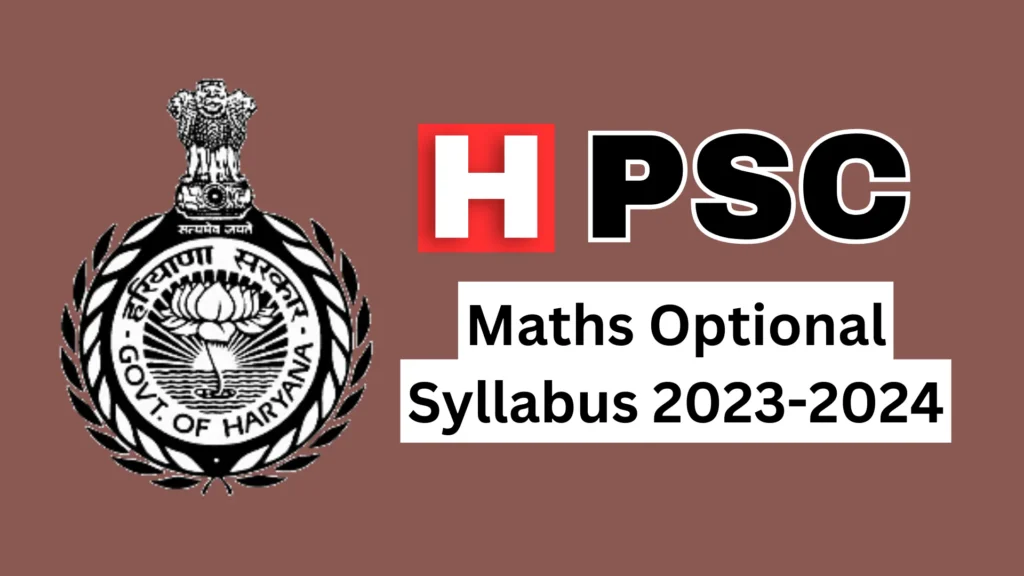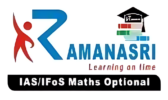
HPSC Maths Optional Syllabus 2024 | HCS Maths Optional Syllabus | RAMANA SRI IAS
As per the HPSC Notification 2023, 94 vacancies will be filled up by the Commission through HPSC HCS Exam 2023. To achieve success in the Civil Services examination, candidates need to prepare well. This includes developing an effective study plan and understanding the HPSC Maths Optional Syllabus or HCS Maths Optional Syllabus of the exam. Moreover, a strong grasp of the HPSC Maths Optional Syllabus or HCS Maths Optional Syllabus is also crucial for selecting the right books and study materials to aid in preparation.
Aspirants must familiarize themselves with the HPSC Maths Optional Syllabus or HCS Maths Optional Syllabus for HPSC Civil Services Exam so that they can identify the topics and sub-topics they need to focus on. They must also select appropriate study materials and create a well-structured study plan that allocates time for each topic. Additionally, they should seek out relevant and reliable online resources to supplement their preparation.
To make the most of their preparations, candidates should practice as much as possible. This can be done through attempting mock tests, answering previous year questions, and reading up on the latest developments in their field of study. It is also important to attend coaching classes, as they can provide valuable guidance and support in preparing for the HPSC exam.
It is also necessary for candidates to understand the HPSC Civil Services Exam 2024 syllabus of HPSC Maths Optional Syllabus or HCS Maths Optional Syllabus in order to determine what areas they need to focus on. Specifically, the HPSC Preliminary exam comprises two objective-type papers: General Studies and CSAT (Civil Service Aptitude Test). These exams are critical for those aspiring to join the Civil Services and can be challenging for those who do not have a solid understanding of the syllabus.
The CSAT exam is qualifying in nature and does not contribute to the final rank, but it is essential for getting through the selection process. To prepare for the paper, candidates should review the following HPSC Maths Optional Syllabus or HCS Maths Optional Syllabus of HPSC Civil Services Syllabus:
Mechanics and Fluid Dynamics: Generalized coordinates; D’Alembert’s principle and Lagrange’s equations; Hamilton’s equations; Moment of inertia; Motion of rigid bodies in two dimensions. Equation of continuity; Euler’s equation of motion for inviscid flow; Stream-lines, path of a particle; Potential flow; Two-dimensional and axisymmetric motion; Sources and sinks, vortex motion; Navier-Stokes equation for a viscous fluid.
The HPSC Exam consists of three rounds: Prelims, Mains, and Interviews. It is a good idea to begin preparing as early as possible, as the competition will be fierce. It is also a good idea to learn from the experiences of previous IAS Toppers, as they can help you in your preparations. The best way to do this is by identifying the most important aspects of the Civil Services Examination 2024 and learning what to expect in each round. Then, you can develop a study plan that will give you the best chance of success! Good luck with your preparations!
HPSC Maths Optional Syllabus Paper-1 | HCS Maths Optional Syllabus Paper-1
| (1) Linear Algebra: Vector spaces over R and C, linear dependence and independence, subspaces, bases, dimensions, Linear transformations, rank and nullity, matrix of a linear transformation. Algebra of Matrices; Row and column reduction, Echelon form, congruence‘s and similarity; Rank of a matrix; Inverse of a matrix; Solution of system of linear equations; Eigenvalues and eigenvectors, characteristic polynomial, Cayley-Hamilton theorem, Symmetric, skew-symmetric, Hermitian, skewHermitian, orthogonal and unitary matrices and their eigenvalues. |
| (2) Calculus: Real numbers, functions of a real variable, limits, continuity, differentiability, mean-value theorem, Taylor‘s theorem with remainders, indeterminate forms, maxima and minima, asymptotes; Curve tracing; Functions of two or three variables; Limits, continuity, partial derivatives, maxima and minima, Lagrange‘s method of multipliers, Jacobian. Riemann‘s definition of definite integrals; Indefinite integrals; Infinite and improper integral; Double and triple integrals (evaluation techniques only); Areas, surface and volumes. |
| (3) Analytic Geometry: Cartesian and polar coordinates in three dimensions, second degree equations in three variables, reduction to Canonical forms; straight lines, shortest distance between two skew lines, Plane, sphere, cone, cylinder, paraboloid, ellipsoid, hyperboloid of one and two sheets and their properties. |
| (4) Ordinary Differential Equations: Formulation of differential equations; Equations of first order and first degree, integrating factor; Orthogonal trajectory; Equations of first order but not of first degree, Clairaut‘s equation, singular solution. Second and higher order liner equations with constant coefficients, complementary function, particular integral and general solution. Section order linear equations with variable coefficients, Euler-Cauchy equationDetermination of complete solution when one solution is known using method of variation of parameters. Laplace and Inverse Laplace transforms and their properties, Laplace transforms of elementary functions. Application to initial value problems for 2nd order linear equations with constant coefficients. |
| (5) Dynamics and Statics: Rectilinear motion, simple harmonic motion, motion in a plane, projectiles; Constrained motion; Work and energy, conservation of energy; Kepler‘s laws, orbits under central forces. Equilibrium of a system of particles; Work and potential energy, friction, Common catenary; Principle of virtual work; Stability of equilibrium, equilibrium of forces in three dimensions. |
| (6) Vector Analysis: Scalar and vector fields, differentiation of vector field of a scalar variable; Gradient, divergence and curl in cartesian and cylindrical coordinates; Higher order derivatives; Vector identities and vector equation. Application to geometry: Curves in space, curvature and torsion; Serret-Furenet’s formulae. Gauss and Stokes‘ theorems, Green’s indentities |
HPSC Maths Optional Syllabus Paper-2 | HCS Maths Optional Syllabus Paper-2
| (1) Algebra: Groups, subgroups, cyclic groups, cosets, Lagrange‘s Theorem, normal subgroups, quotient groups, hcsomomorphism of groups, basic isomorphism theorems, permutation groups, Cayley‘s theorem. Rings, subrings and ideals, homomorphisms of rings; Integral domains, principal ideal domains, Euclidean domains and unique factorization domains; Fields, quotient fields. |
| (2) Real Analysis: Real number system as an ordered field with least upper bound property; Sequences, limit of a sequence, Cauchy sequence, completeness of real line; Series and its convergence, absolute and conditional convergence of series of real and complex terms, rearrangement of series. Continuity and uniform continuity of functions, properties of continuous functions on compact sets. Riemann integral, improper integrals; Fundamental theorems of integral calculus. Uniform convergence, continuity, differentiability and integrability for sequences and series of functions; Partial derivatives of functions of several (two or three) variables, maxima and minima. |
| (3) Complex Analysis: Analytic function, Cauchy-Riemann equations, Cauchy’s theorem, Cauchy’s integral formula, power series, representation of an analytic function, Taylor‘s series; Singularities; Laurent‘s series; Cauchy‘s residue theorem; Contour integration. |
| (4) Linear Programming: Linear programming problems, basic solution, basic feasible solution and optimal solution; Graphical method and simplex method of solutions; Duality. Transportation and assignment problems. |
| (5) Partial Differential Equations: Family of surfaces in three dimensions and formulation of partial differential equations; Solution of quasilinear partial differential equations of the first order, Cauchy‘s method of characteristics; Linear partial differential equations of the second order with constant coefficients, canonical form; Equation of a vibrating string, heat equation, Laplace equation and their solutions. |
| (6) Numerical Analysis and Computer Programming: Numerical methods: Solution of algebraic and transcendental equations of one variable by bisection, Regula-Falsi and Newton-Raphson methods, solution of system of linear equations by Gaussian Elimination and Gauss-Jorden (direct), Gauss-Seidel (iterative) methods. Newton‘s (forward and backward) and interpolation, Lagrange‘s interpolation. Numerical integration: Trapezoidal rule, Simpson‘s rule, Gaussian quadrature formula. Numerical solution of ordinary differential equations: Eular and Runga Kutta methods. Computer Programming: Binary system; Arithmetic and logical operations on numbers; Octal and Hexadecimal Systems; Conversion to and from decimal Systems; Algebra of binary numbers. Elements of computer systems and concept of memory; Basic logic gates and truth tables, Boolean algebra, normal forms. Representation of unsigned integers, signed integers and reals, double precision reals and long integers. reals and long integers. Algorithms and flow charts for solving numerical analysis problems. |
| (7) Mechanics and Fluid Dynamics: Generalised coordinates; D‘Alembert‘s principle and Lagrange‘s equations; Hamilton equations; Moment of inertia; Motion of rigid bodies in two dimensions. Equation of continuity; Euler‘s equation of motion for inviscid flow; Stream-lines, path of a particle; Potential flow; Two-dimensional and axisymmetric motion; Sources and sinks, vortex motion; Navier-Stokes equation for a viscous fluid. |
